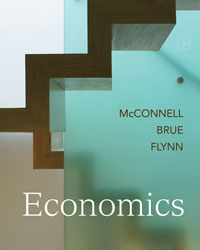
Economics (McConnell), 18th EditionChapter 14: Rent, Interest, and ProfitOrigin of the Idea
Interest has been a subject of debate for centuries, but Irving Fisher (1867-1947) was one of the first economists to develop a comprehensive theory of how interest is determined. Fisher's first work on the subject, The Rate of Interest, was published in 1906. His 1930 publication, The Theory of Interest, expanded and refined his earlier work. Fisher asserted that two forces determine the interest rate: the "impatience rate" and the "investment opportunity rate." The impatience rate represents the community's willingness to sacrifice future consumption (also representing income) for present consumption. Higher impatience rates represent greater willingness to sacrifice future for present consumption. The supply of loanable funds curve in Figure 29.2 of the text is a function of the impatience rate. Ceteris paribus, the higher the impatience rate, the steeper the supply curve, as a more impatient community must be offered higher rewards (interest) to forgo a given amount of present consumption. The investment opportunity rate was Fisher's explanation for why the demand for loanable funds curve in Figure 29.2 is down- sloping. Resource quality and availability, combined with technology, determine the possible combinations of present and future consumption. Starting from the point of engaging only in present consumption, the rate of return on investments (for future consumption) is high. As more present consumption is sacrificed for investments in future consumption, diminishing marginal returns reduce the rate of return on those investments. The diminishing rates of return require lower rates of interest to induce further investment, hence the down-sloping demand curve. While we can demonstrate Fisher's ideas in the familiar supply and demand model, Fisher himself used production possibilities (chapter 2) and indifference curves (chapter 21 appendix) to illustrate his theory. Irving Fisher was a man of eclectic interests. Prior to his life as an economist, Fisher was a professor of mathematics at Yale, and wrote a number of popular mathematics textbooks (popular, at least, to the professors who used them). Fisher was also something of an inventor, but his only profitable invention was the rotary index card file, better known today by the trademark name "Rolodex." Fisher earned about $1 million for the invention, which grew to the princely sum of $9 million before being lost in the stock market crash of 1929. Because of his own health problems, Fisher studied diet and health fads, and wrote several books on leading a healthy lifestyle. His interest in medical issues carried over into support for eugenics and opposition to tobacco and alcohol. In the area of public policy, campaigned for Prohibition, advised President Franklin D. Roosevelt on monetary policy from 1932 to 1937, and proposed a league of nations, long before World War I and the Treaty of Versailles.
Today the term "usury" refers to the charging of excessive interest rates. Historically, and as the term is used here, it applied to any charging of interest. The debate on usury can be traced back at least as far as Aristotle. In his Politics, Aristotle discusses "wealth-getting," or providing ones income, through exchange and production. Of these two "arts," Aristotle writes, "the latter branch [production] is necessary and in good esteem, but the branch connected with exchange is justly discredited (for it is not in accordance with nature, but involves men's taking things from one another). As this is so, usury is most reasonably hated, because its gain comes from money itself and not from that for the sake of which money was invented. For money was brought into existence for the purpose of exchange, but interest increases the amount of money itself ...; consequently this form of the business of getting wealth is of all forms the most contrary to nature."[1] Saint Thomas Aquinas (1225-1274), the medieval theologian, was equally opposed to usury, in his case on religious grounds. For Aquinas, Christians should be charitable in their lending, and he saw the charging of interest as greedy and exploitative. Biblical support for his position came from Luke 6:35, where Jesus instructs to "Lend freely, hoping nothing thereby." In part as a result of the strong church opposition, lending for interest was widely prohibited during the Middle Ages (approximately 500-1500). Over time this gave way to usury laws that set maximum rates of interest on loans. Support for these laws was strong, even from the likes of classical economist Adam Smith (1723-1790) and others that generally supported minimal government intervention. Support for usury laws, however, was not universal, and classical economist Jeremy Bentham (1748-1832) rejected the assertion that government controls on interest rates were necessary or beneficial. He believed that individuals are better judges of the worth of money to themselves. Setting limits on interest rates might be detrimental as it would prevent some from securing loans that would be ultimately beneficial.
|  |















